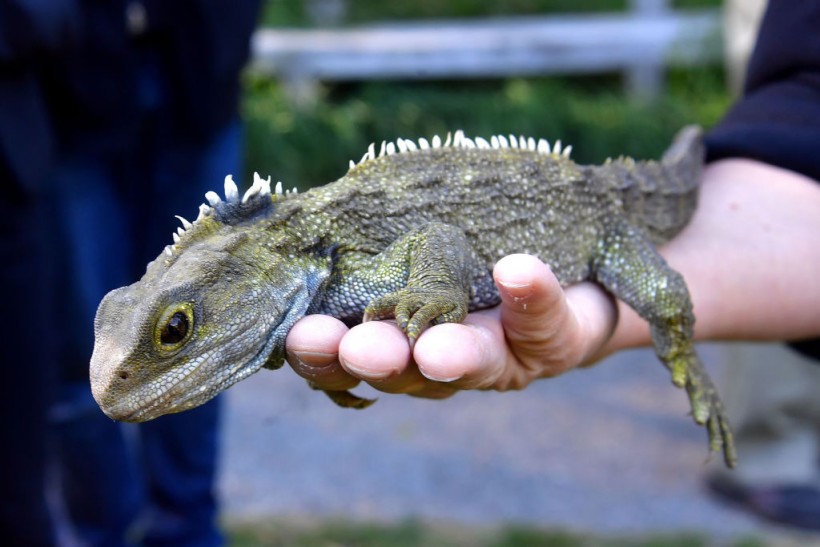The newly discovered extinct species of lizard-like reptile is said to belong to the same ancient lineage of the tuatara that lives in New Zealand. The Smithsonian researchers named it Opisthiamimus gregori, which lived about 150 million years ago during the mid-Mesozoic era alongside other dinosaurs like Stegosaurus and Allosaurus.
The team says that Science Daily reported that the prehistoric lizard would have been about 6 inches (16 centimeters) from its nose to the tail and would fit a palm of an adult human hand. They added that the new species might have lived on a diet of insects and other invertebrates.

A Tuatara named Tane at Zealandia wildlife park is held in Wellington on November 7, 2017.
New Lizard-Like Species A Relative of the Rhynchocephalians
The team discovered a handful of specimens, including the complete and well-preserved fossil skeleton found in the Morrison Formation in northern Wyoming. Although the new extinct species may look like a lizard, researchers clarified that it is a rhynchocephalian, a group of species that diverged from lizards about 230 million years ago.
The study, titled "A nearly complete skeleton of a new eusphenodontian from the Upper Jurassic Morrison Formation, Wyoming, USA, provides insight into the evolution and diversity of Rhynchocephalia (Reptilia: Lepidosauria)" published in the Journal of Systematic Palaeontology, discusses the discovery of the fossils of the small new species of extinct rhynchocephalian that lived in the North American terrains alongside dinosaurs 1'50 million years ago.
The team says that the rhynchocephalians are a group of reptiles closely related to lizards. According to Discovery, these reptiles ranged in shape and size as well as performed various functions as aquatic predators and terrestrial prey. However, they remain a mystery to reptile researchers.
Dinosaur curator Matthew Carrano from the Smithsonian National Museum of Natural History said in a press release that these animals may have disappeared partly due to the competition from lizards and global shifts in the climate, as well as changing habitats.
Today, only one species of rhynchocephalian survives the Sphendon punctatus. Commonly called the tuatara, this reptile resembles the stout, stocky iguana. The only remaining rhynchocephalian species are also the last avenue for scientists to study why rhynchocephalians are slowly dying.
ALSO READ: Re-Analysis of T. Rex Dinosaur Fossils Refutes Theory Claiming There Are 3 Tyrannosaurus rex Species
Solving A Persistent Problem in the Study of Reptiles
The discovery of O. gregori opens another valuable source of information about rhynchocephalians aside from the tuatara. Researchers are positive that it could one day show why these species declined to only one surviving species.
MailOnline reports that the newly discovered extinct species has now been officially added to the Smithsonian museum collections, where it will remain available for future study.
Carrano said that they would need more evidence, such as with O. gregori, to explain what exactly happened in the past that led to the extinction of most rhynchocephalians.
The new species was named after the museum volunteer Joseph Gregor who spent hundreds of hours meticulously scraping and chiseling the bones from a block of stone found by preparatory Pete Kroehler in 2010. Pete is said to have noticed two specks of bone on the side of the stone and marked it without knowing what was inside it, which turned out to be a new extinct species.
RELATED ARTICLE: Nearly 60 Million Years of Climate Change Triggered the Rapid Evolution of Reptiles, Study Finds
Check out more news and information on Paleontology in Science Times.


![Earth's Quasi-Moon Kamo‘oalewa Could Originate From Lunar Surface Not Asteroid Belt [Study]](https://1721181113.rsc.cdn77.org/data/thumbs/full/53275/89/56/50/40/earths-quasi-moon-kamo-oalewa-could-originate-from-lunar-surface-not-asteroid-belt-study.png)











